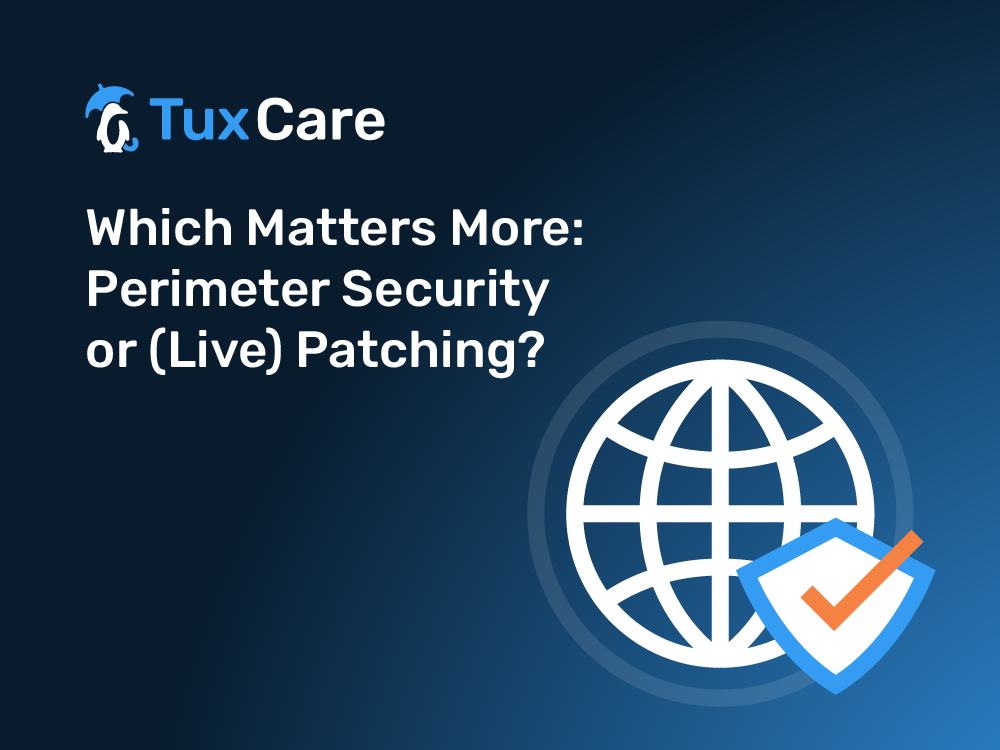Which Matters More: Perimeter Security or (Live) Patching?
If you have limited resources, what should you do first: make your systems more tamper proof by patching where and when you can, or ensure that outsiders stay outside through comprehensive perimeter security? Both are key cybersecurity prerogatives, after all.
In this article, we’ll outline both perimeter security and patching, their respective benefits and challenges, and explain why – in some circumstances – patching requires fewer resources and is therefore the cybersecurity endeavor that you should get right first.
What Is Perimeter Security and Why Does It Matter?
Perimeter security is a set of measures that an organization implements to secure its network from unauthorized access by external entities. It aims to protect an internal network from external threats, such as hackers, malware, and viruses, by creating a barrier around the network.
Many cybersecurity features work in concert to achieve perimeter security, including firewalls, intrusion detection systems, and access controls.
Perimeter security matters because it helps to protect an organization’s sensitive data, intellectual property, and other critical assets. That’s why many regulatory compliance frameworks require organizations to have adequate perimeter security measures in place.
Of course, while perimeter security is essential, it’s not enough to ensure complete network security – never mind comprehensive cybersecurity across the entire organization. Perimeter security is never perfect, and there’s always an insider threat as well.
Organizations therefore also implement measures such as data encryption, multi-factor authentication, and regular security audits to stay ahead of evolving cyber threats… and they also need to patch.
What About Patching?
While perimeter security is intended to prevent outsiders from reaching inside, patching ensures that your systems are secure against tampering: whether it’s from an insider or an outsider that worked to find their way in.
As you probably already know, cybersecurity patching is the process of updating software or firmware to address known security vulnerabilities that can be exploited by attackers.
Patching is essential for protecting computer systems and data from cyber-attacks because patches address specific security vulnerabilities that have been identified in software or firmware. By applying the patch, the vulnerability is addressed, and the system is made more secure.
Consistently patching is effective because cyber attackers often target known vulnerabilities in software or firmware to gain unauthorized access or take control of a system before companies get around to applying the patch for those vulnerabilities. By applying cybersecurity patches promptly, organizations can prevent these attacks. It doesn’t matter whether the attacker is an insider or an outsider – patching accomplishes the same thing.
Which Is More Effective?
Like every other cybersecurity measure, the effectiveness of perimeter security is determined by a whole mix of factors – from circumstances to the effort applied to perimeter security:
- Threat landscape: The effectiveness of perimeter security depends on the threat landscape of the organization. The types and levels of threats that the organization faces will dictate the strength and type of security measures that need to be put in place.
- Technology used: Choosing the right mix of tools, such as firewalls, intrusion detection and prevention systems (IDPS), and antivirus software, matters. As always, the more advanced and up to date the technology used, the more secure a perimeter will be.
- Monitoring and response: Measures must be monitored regularly to identify potential threats and respond to them quickly. Effective monitoring and response can help to prevent or mitigate attacks before they can cause damage.
You can probably see a pattern emerging here: the right tools alongside a good deal of effort can turn perimeter response into an effective measure. What about patching? Here’s what you need to get patching right:
- Vulnerability identification and prioritization: This can be done through various means, such as vulnerability scans, penetration testing, or monitoring security bulletins from vendors and industry sources. Once the vulnerabilities are identified, it’s important to prioritize based on severity.
- Testing and validation: Before deploying the patches, it’s important to test them thoroughly to ensure that they don’t introduce any new problems or vulnerabilities. This may involve testing in a lab environment, as well as testing in a production environment with a small group of users.
- Deployment: Once the patches have been tested and validated, patches must be deployed as fast as possible – and, if the patch is critical, then it must be deployed immediately. However, the speed at which patches are deployed depends greatly on the workload and availability of staff.
- Monitoring: Even after the patches have been deployed and verified, it’s important to continue monitoring systems for any signs of compromise or new vulnerabilities. This can be done through continuous monitoring and periodic vulnerability scans.
The right tools alongside lots and lots of cybersecurity manpower are needed to make sure that patching happens regularly.
If a team can manage to maintain patching consistently, then an argument can be made that patching is more important – because many breaches can occur through known vulnerabilities that have not yet been patched.
Perimeter security is important, but it is just one of several layers of defense that need to be in place to maintain a secure network. There is a caveat though: most sysadmin teams struggle with consistent patching, which is due to a variety of reasons.
These reasons include limited resources, lack of prioritization, complexity of systems, lack of communication, and a fear of disrupting critical systems. These challenges can lead to delays in patching vulnerabilities, leaving systems exposed to potential security threats.
This Is Where Live Patching Comes In
Live patching allows for critical security patches and bug fixes to be applied to a running system without the need for downtime or rebooting. This reduces service disruptions, improves system availability, and helps to maintain business continuity. Additionally, live patching can also increase system security by reducing the time that a vulnerability is exposed to potential attackers.
And here’s where the difference is seen between perimeter security and (live) patching. Yes, you can automate perimeter security to a degree, but it remains a time-consuming cybersecurity task that requires regular human intervention to monitor and verify.
In contrast, live patching is a “set and forget” activity. Configure live patching to cover a system and your team can be certain that the patches will be applied on schedule, without you needing to manually make it happen.
No, It’s Not Really a Comparison After All
We’ve got you reading this far, and it’s time that we own up. You can’t really compare perimeter security and patching as security measures, because both are critical components for cybersecurity, each for their own reasons.
Our point is this, however. If you can automate or otherwise improve a cybersecurity process, then you should take that opportunity. Live patching is an easy win – there’s little reason not to adopt it, and by including live patching in your cybersecurity arsenal you get at least one thing done right.
At TuxCare, we can cover you for live patching across much of the most critical software you use in your organization. That includes your Linux operating system kernels for all popular distributions, shared libraries, databases – and even commonly-used virtualization solutions. Read more about TuxCare’s enterprise live patching capabilities here.



 Documentation
Documentation Login
Login



